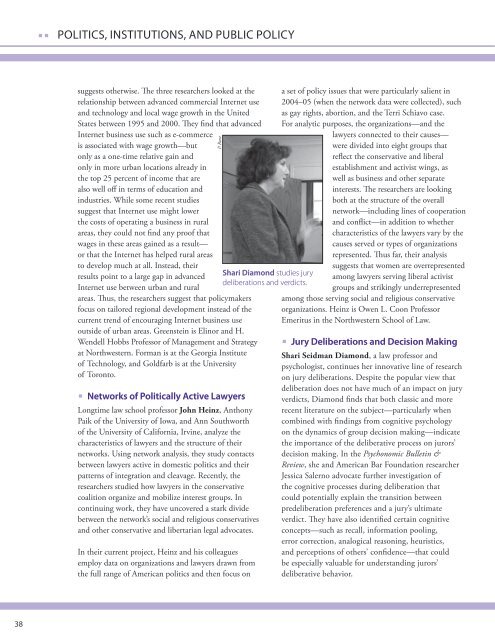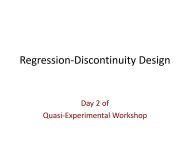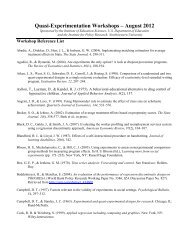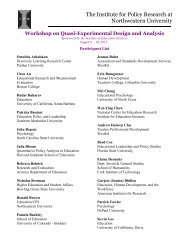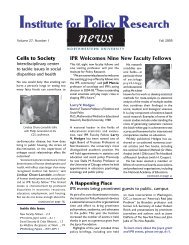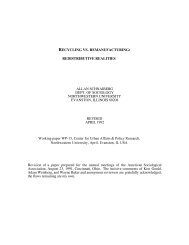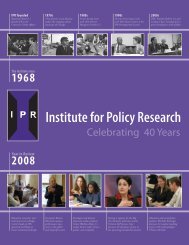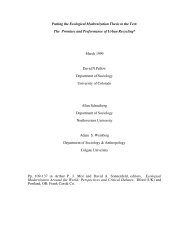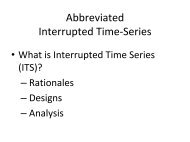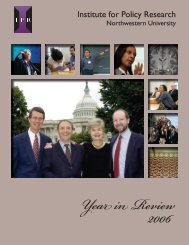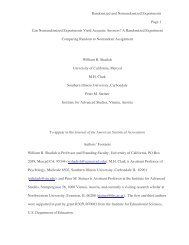Overview of Activities - Institute for Policy Research - Northwestern ...
Overview of Activities - Institute for Policy Research - Northwestern ...
Overview of Activities - Institute for Policy Research - Northwestern ...
Create successful ePaper yourself
Turn your PDF publications into a flip-book with our unique Google optimized e-Paper software.
P. Reese<br />
POLITICS, INSTITUTIONS, AND PUBLIC POLICY<br />
suggests otherwise. The three researchers looked at the<br />
relationship between advanced commercial Internet use<br />
and technology and local wage growth in the United<br />
States between 1995 and 2000. They find that advanced<br />
Internet business use such as e-commerce<br />
is associated with wage growth—but<br />
only as a one-time relative gain and<br />
only in more urban locations already in<br />
the top 25 percent <strong>of</strong> income that are<br />
also well <strong>of</strong>f in terms <strong>of</strong> education and<br />
industries. While some recent studies<br />
suggest that Internet use might lower<br />
the costs <strong>of</strong> operating a business in rural<br />
areas, they could not find any pro<strong>of</strong> that<br />
wages in these areas gained as a result—<br />
or that the Internet has helped rural areas<br />
to develop much at all. Instead, their<br />
results point to a large gap in advanced<br />
Internet use between urban and rural<br />
areas. Thus, the researchers suggest that policymakers<br />
focus on tailored regional development instead <strong>of</strong> the<br />
current trend <strong>of</strong> encouraging Internet business use<br />
outside <strong>of</strong> urban areas. Greenstein is Elinor and H.<br />
Wendell Hobbs Pr<strong>of</strong>essor <strong>of</strong> Management and Strategy<br />
at <strong>Northwestern</strong>. Forman is at the Georgia <strong>Institute</strong><br />
<strong>of</strong> Technology, and Goldfarb is at the University<br />
<strong>of</strong> Toronto.<br />
< Networks <strong>of</strong> Politically Active Lawyers<br />
Longtime law school pr<strong>of</strong>essor John Heinz, Anthony<br />
Paik <strong>of</strong> the University <strong>of</strong> Iowa, and Ann Southworth<br />
<strong>of</strong> the University <strong>of</strong> Cali<strong>for</strong>nia, Irvine, analyze the<br />
characteristics <strong>of</strong> lawyers and the structure <strong>of</strong> their<br />
networks. Using network analysis, they study contacts<br />
between lawyers active in domestic politics and their<br />
patterns <strong>of</strong> integration and cleavage. Recently, the<br />
researchers studied how lawyers in the conservative<br />
coalition organize and mobilize interest groups. In<br />
continuing work, they have uncovered a stark divide<br />
between the network’s social and religious conservatives<br />
and other conservative and libertarian legal advocates.<br />
In their current project, Heinz and his colleagues<br />
employ data on organizations and lawyers drawn from<br />
the full range <strong>of</strong> American politics and then focus on<br />
Shari Diamond studies jury<br />
deliberations and verdicts.<br />
a set <strong>of</strong> policy issues that were particularly salient in<br />
2004–05 (when the network data were collected), such<br />
as gay rights, abortion, and the Terri Schiavo case.<br />
For analytic purposes, the organizations—and the<br />
lawyers connected to their causes—<br />
were divided into eight groups that<br />
reflect the conservative and liberal<br />
establishment and activist wings, as<br />
well as business and other separate<br />
interests. The researchers are looking<br />
both at the structure <strong>of</strong> the overall<br />
network—including lines <strong>of</strong> cooperation<br />
and conflict—in addition to whether<br />
characteristics <strong>of</strong> the lawyers vary by the<br />
causes served or types <strong>of</strong> organizations<br />
represented. Thus far, their analysis<br />
suggests that women are overrepresented<br />
among lawyers serving liberal activist<br />
groups and strikingly underrepresented<br />
among those serving social and religious conservative<br />
organizations. Heinz is Owen L. Coon Pr<strong>of</strong>essor<br />
Emeritus in the <strong>Northwestern</strong> School <strong>of</strong> Law.<br />
< Jury Deliberations and Decision Making<br />
Shari Seidman Diamond, a law pr<strong>of</strong>essor and<br />
psychologist, continues her innovative line <strong>of</strong> research<br />
on jury deliberations. Despite the popular view that<br />
deliberation does not have much <strong>of</strong> an impact on jury<br />
verdicts, Diamond finds that both classic and more<br />
recent literature on the subject—particularly when<br />
combined with findings from cognitive psychology<br />
on the dynamics <strong>of</strong> group decision making—indicate<br />
the importance <strong>of</strong> the deliberative process on jurors’<br />
decision making. In the Psychonomic Bulletin &<br />
Review, she and American Bar Foundation researcher<br />
Jessica Salerno advocate further investigation <strong>of</strong><br />
the cognitive processes during deliberation that<br />
could potentially explain the transition between<br />
predeliberation preferences and a jury’s ultimate<br />
verdict. They have also identified certain cognitive<br />
concepts—such as recall, in<strong>for</strong>mation pooling,<br />
error correction, analogical reasoning, heuristics,<br />
and perceptions <strong>of</strong> others’ confidence—that could<br />
be especially valuable <strong>for</strong> understanding jurors’<br />
deliberative behavior.<br />
S<br />
ocial Disparities<br />
and Health<br />
IPR 2009<br />
IPR’s Cells to Society (C2S): The Center on Social Disparities and Health continues to expand its<br />
scope <strong>of</strong> activities to understand how social, economic, and cultural contexts affect physical and<br />
mental health, as well as cognitive achievement, at the population level. Faculty research overlaps<br />
with other IPR program areas, including Child, Adolescent, and Family Studies; Poverty, Race,<br />
and Inequality; and Education <strong>Policy</strong> (see pp. 10–24). Lindsay Chase-Lansdale, a developmental<br />
psychologist, is C2S’s founding director. Currently, the center has three signature research themes:<br />
• social disparities, stress, and health<br />
• families, interpersonal relationships, and health<br />
• longevity, mortality, and preconception-to-adult models <strong>of</strong> health<br />
<strong>Overview</strong> <strong>of</strong> <strong>Activities</strong><br />
< First Joint Appointment with the<br />
Medical School<br />
Clinical and developmental psychologist Lauren<br />
Wakschlag became the first IPR/C2S faculty fellow<br />
from <strong>Northwestern</strong>’s Feinberg School <strong>of</strong> Medicine to<br />
hold a term appointment. The position will specifically<br />
link the medical and social sciences at <strong>Northwestern</strong><br />
by bridging C2S and the newly created Feinberg<br />
Department <strong>of</strong> Medical Social Sciences (MSS). In<br />
addition to her IPR/C2S faculty fellow appointment,<br />
Wakschlag serves as MSS pr<strong>of</strong>essor and associate<br />
chair <strong>for</strong> scientific development and institutional<br />
collaboration. With this appointment, IPR is advancing<br />
the One <strong>Northwestern</strong> initiative that seeks to integrate<br />
research conducted on the Chicago and Evanston<br />
campuses in the life, biomedical, and social sciences.<br />
MSS was founded in 2009 by David Cella, an<br />
international leader in biomedical outcomes research.<br />
This department is affiliated with C2S and is part<br />
<strong>of</strong> a growing ef<strong>for</strong>t by <strong>Northwestern</strong> to more closely<br />
integrate biomedical and social sciences to improve<br />
health and healthcare delivery in diverse populations<br />
over the lifespan. MSS focuses on developing<br />
measurement methods and approaches applicable across<br />
a range <strong>of</strong> health and disease states. It also aims to<br />
rapidly translate basic discoveries into applications <strong>for</strong><br />
treating specific diseases, such as cancer, neurological<br />
disease, and early onset psychopathology.<br />
< Add Health and Biomarkers<br />
A team <strong>of</strong> C2S researchers is investigating the<br />
impact <strong>of</strong> socioeconomic status, social relationships,<br />
Chair<br />
Lindsay Chase-Lansdale, Human Development<br />
and Social <strong>Policy</strong><br />
The goal <strong>of</strong> C2S is to integrate the social, behavioral, biomedical,<br />
and life sciences to illuminate pathways contributing to health<br />
inequalities and to develop translational and policy solutions.<br />
38<br />
39


